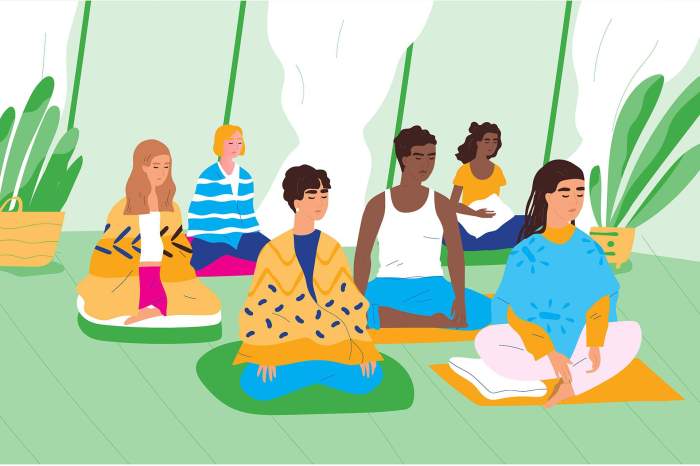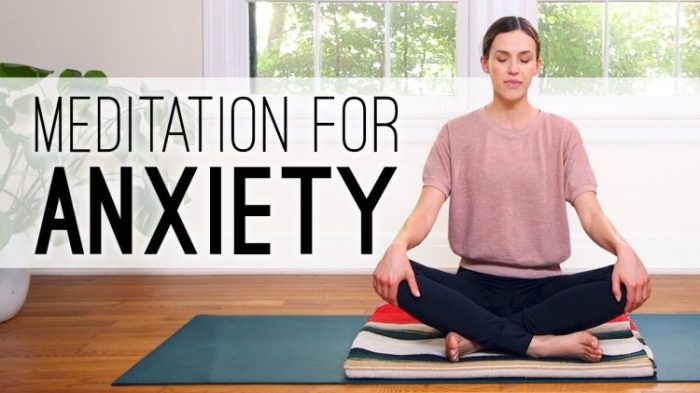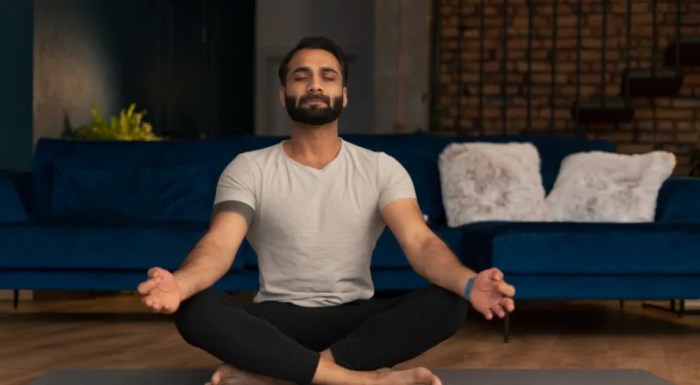Embark on a journey with guided meditation for anxiety and depression, uncovering how this practice can bring peace and calm amidst life’s chaos.
Delve into the realm of mindfulness and relaxation as we navigate through the realms of guided meditation.
Introduction to Guided Meditation for Anxiety and Depression

Source: mindful.org
Guided meditation is a form of meditation where an individual is led by a trained practitioner or through recorded audio to help focus and calm the mind. This practice involves visualization, deep breathing, and mindfulness techniques to promote relaxation and reduce stress.
Guided meditation can be particularly beneficial for individuals dealing with anxiety and depression. By following the guidance of an instructor or audio recording, individuals can learn to quiet their minds, manage intrusive thoughts, and cultivate a sense of inner peace. This can help alleviate symptoms of anxiety and depression, improve mood, and promote overall well-being.
The Importance of Finding the Right Guided Meditation Practice
It is essential to find the right guided meditation practice that resonates with you personally. Different practices may focus on various techniques or themes, so it’s important to explore and find one that feels comfortable and effective for your needs. Here are some reasons why finding the right guided meditation practice is crucial:
- Personal Connection: A guided meditation practice that resonates with you can establish a personal connection and make the practice more meaningful.
- Effectiveness: The right practice can be more effective in helping you manage anxiety and depression symptoms and promote emotional well-being.
- Consistency: When you find a practice that works for you, you are more likely to stick with it consistently, reaping long-term benefits.
- Customization: Some guided meditation practices allow for customization based on individual preferences and needs, enhancing the overall experience.
Understanding Anxiety and Depression

Source: imwithherglobal.com
Anxiety and depression are two common mental health conditions that can significantly impact a person’s well-being. While they share some similarities, they also have distinct characteristics that differentiate them from each other.Anxiety is often characterized by feelings of worry, nervousness, or unease about a specific situation or event. It can manifest as physical symptoms such as increased heart rate, sweating, and trembling.
Individuals with anxiety may also experience racing thoughts, difficulty concentrating, and restlessness.Depression, on the other hand, is marked by persistent feelings of sadness, hopelessness, and a lack of interest in activities that were once enjoyable. Physical symptoms of depression may include changes in appetite or weight, sleep disturbances, and fatigue. People with depression may also have trouble with decision-making, experience feelings of worthlessness, and have thoughts of self-harm or suicide.Both anxiety and depression can have a profound impact on a person’s mental health, affecting their ability to function in daily life.
It is important to seek help from a mental health professional if you or someone you know is experiencing symptoms of anxiety or depression.
Benefits of Guided Meditation for Anxiety and Depression
Guided meditation has been shown to offer numerous benefits for managing anxiety and depression. By incorporating relaxation techniques and mindfulness practices, guided meditation can provide relief and support for individuals struggling with these mental health challenges.
Promotes Relaxation and Reduces Stress
- Guided meditation helps individuals relax both their mind and body, allowing them to release tension and stress that may be contributing to feelings of anxiety and depression.
- Through focused breathing and visualization exercises, guided meditation encourages a state of calmness and tranquility, aiding in alleviating symptoms of anxiety and depression.
- Regular practice of guided meditation can lead to a reduction in the body’s stress response, promoting overall well-being and mental clarity.
Mindfulness Techniques for Anxiety and Depression
- Guided meditation often incorporates mindfulness techniques that can help individuals become more aware of their thoughts and emotions, allowing them to better manage and cope with feelings of anxiety and depression.
- By practicing mindfulness during guided meditation sessions, individuals can develop a greater sense of self-awareness and acceptance, which can be beneficial in challenging negative thought patterns associated with anxiety and depression.
- Learning to focus on the present moment through mindfulness techniques can help individuals reduce rumination about the past or worries about the future, leading to a decrease in anxiety and depressive symptoms.
How to Start with Guided Meditation for Anxiety and Depression

Source: zameela.com
Starting a guided meditation practice can help in managing anxiety and depression effectively. Here are some steps to begin:
Step-by-Step Guide to Begin Guided Meditation:
- Find a quiet and comfortable place to sit or lie down.
- Choose a guided meditation resource or app that resonates with you. Some popular options include Headspace, Calm, and Insight Timer.
- Set a specific time each day to practice guided meditation to establish a routine.
- Follow the instructions provided in the guided meditation session, focusing on your breath and sensations in your body.
- Start with short sessions, gradually increasing the duration as you become more comfortable with the practice.
Recommended Resources for Guided Meditation:
There are various resources and apps available to help you start with guided meditation. Some recommended options include:
Headspace: Offers guided meditation sessions for beginners and advanced practitioners.
Calm: Provides guided meditations, sleep stories, and relaxation techniques to reduce anxiety and stress.
Insight Timer: Offers a wide range of guided meditations, music tracks, and talks by meditation teachers.
Tips for Creating a Peaceful Meditation Environment:
- Dim the lights or light a candle to create a calming atmosphere.
- Use comfortable cushions or a chair to support your posture during meditation.
- Avoid distractions by turning off electronic devices or choosing a quiet space away from noise.
- Play soft music or nature sounds in the background to enhance relaxation.
- Practice gratitude and positive affirmations before and after each meditation session to boost your mood.
Types of Guided Meditation Techniques for Anxiety and Depression
Guided meditation offers various techniques to help individuals cope with anxiety and depression. Each technique focuses on different aspects of the mind and body to promote relaxation and emotional well-being.
Body Scan Meditation
Body scan meditation involves focusing on different parts of the body, progressively moving from head to toe. This technique helps individuals become more aware of bodily sensations, release tension, and cultivate mindfulness. Example script: “Begin by bringing your attention to the top of your head, slowly scanning down to your toes, noticing any sensations without judgment.”
Loving-Kindness Meditation
Loving-kindness meditation centers around cultivating feelings of compassion and love towards oneself and others. This practice can help reduce negative self-talk, enhance empathy, and foster a sense of connection with others. Example script: “May I be happy, may I be healthy, may I be at peace. May all beings be happy, may all beings be healthy, may all beings be at peace.”
Visualization Meditation
Visualization meditation involves creating mental images of peaceful scenes or positive outcomes. By visualizing calming settings or desired goals, individuals can reduce stress, increase optimism, and improve mood. Example script: “Imagine yourself in a serene forest, surrounded by lush greenery and gentle streams. Feel the tranquility and peace washing over you.”
Personal Experiences and Testimonials

Source: choosingtherapy.com
In this section, we will explore personal stories of individuals who have found relief from anxiety and depression through guided meditation. We will also discuss how guided meditation has positively impacted mental health and include testimonials from mental health professionals on its effectiveness.
Case Studies of Individuals
- Amy, a young professional, struggled with anxiety for years. After incorporating guided meditation into her daily routine, she noticed a significant decrease in her anxiety levels. She credits the practice for helping her manage stressful situations with more ease.
- John, a retired veteran experiencing depression, found solace in guided meditation sessions tailored for individuals dealing with trauma. He shared how the practice helped him process his emotions and regain a sense of inner peace.
Impact on Mental Health
- Research has shown that guided meditation can reduce symptoms of anxiety and depression by promoting relaxation and mindfulness. Individuals often report feeling calmer, more focused, and better equipped to cope with daily stressors.
- Mental health professionals have observed significant improvements in their patients’ well-being after incorporating guided meditation into their treatment plans. The practice has been associated with enhanced emotional regulation and resilience.
Outcome Summary
As we conclude our exploration of guided meditation for anxiety and depression, remember that amidst the storm of emotions, calmness is always within reach through this transformative practice.